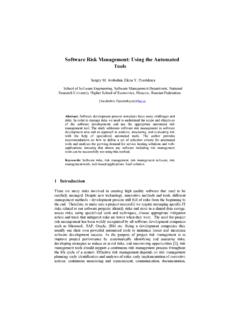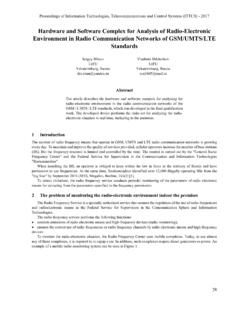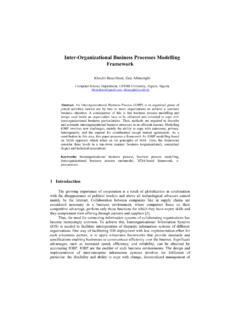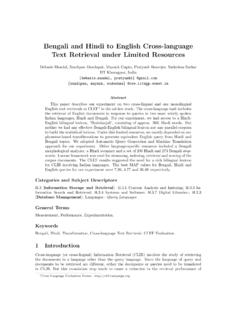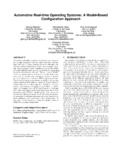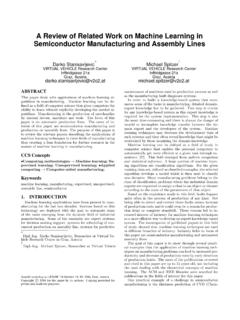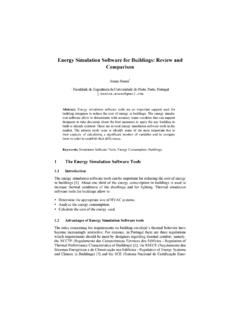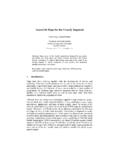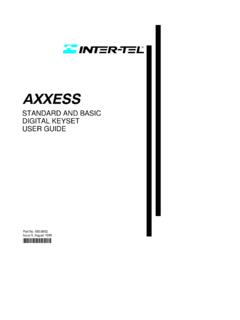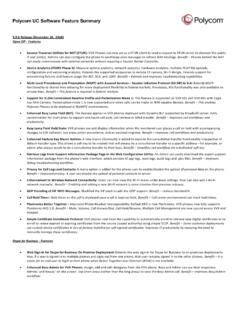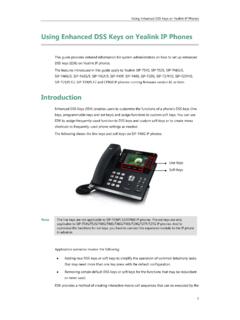Transcription of Towards Enhancing Web Application Security Using Trusted ...
1 Towards Enhancing Web Application SecurityUsing Trusted ExecutionCornelius Namiluko, Andrew J. Paverd, and Tulio De SouzaDepartment of Computer Science, Oxford UniversityWolfson Building, Parks Road, Oxford OX1 3QD, web continues to serve as a powerful medium throughwhich various services and resources can be exposed or consumed throughweb applications . Web Application platforms such aswebinosfacilitatecommunication between the various smart devices in a personal modern web applications use various cryptographic techniquesfor authentication and encryption, the Security of these techniques is di-rectly linked to the Security of the private (secret) keys . Although varioustechniques exist to protect these keys , we argue that the use of securehardware can provide stronger Security guarantees. In particular, we de-scribe our work-in-progress experiments Towards Using functionality pro-vided by a Trusted execution Environment (TEE) in web experiments include an implementation of thewebinosplatformintegrated with ARM TrustZone technology.
2 Our preliminary results arepromising in terms of both the feasibility of implementing this architec-ture and the performance of the :ARM TrustZone, GlobalPlatform, Trusted execution En-vironment, webinos,1 IntroductionWide-spread use of smart mobile devices has opened up a range of new possibil-ities for web applications . feature -rich web applications can be designed to useresources such as web cameras, GPS receivers and Near Field Communication(NFC) transceivers to provide interactive services. As a result, personal informa-tion such as location, messages and contacts is increasingly being exposed to theweb leading to various Security concerns about the confidentiality, integrity andavailability of this sensitive information. Rather than relying on software aloneto manage access to resources on these devices, it has been proposed that protec-tion should be included as part of the hardware platform [3].
3 Grawrock [3] arguesthat a viable approach Towards device Security is through Trusted execution a paradigm in which non- Security sensitive operations cannot influence sensitiveoperations even though both take place on the same platform. This providesthe capability to control access to sensitive information and resources. However, Trusted execution functionality is normally provided at a low level of abstractionand in order for applications running at a higher level of abstraction to utilizethis functionality, there must be mechanisms to expose the functionality in aflexible manner without compromising this paper, we propose that the Security of web applications can be en-hanced through a device-independent framework that enables web applicationsto utilize the functionality provided by Trusted execution .
4 We focus onwebinos1,a state-of-the-art platform for running web applications across multiple of the webinos architecture are presented in Section 2. We propose thatwebinos can be enhanced to take advantage of Trusted execution functionalityprovided by ARM TrustZone technology described in Section 3. In Section 4, wepresent our enhanced webinos architecture in which various cryptographic oper-ations can be performed in the Trusted environment in order to protect sensitiveinformation such as cryptographic keys . We describe our ongoing experimentalwork in Section 5 and present a preliminary evaluation in Section 6. Our pre-liminary results are promising both in terms of the feasibility of implementingthis architecture and the performance of the webinos ArchitectureDevices such as mobile phones, smart TVs, home appliances, energy metersand even cars are now capable of connecting to the Internet, leading to the so-calledInternet of things.
5 It is often the case that an individual will own multipleInternet-connected devices, each providing specific functionality or services. Inorder to take advantage of the composite set of services, there must be a mech-anism for interconnecting these devices and facilitating resource is an example of a system that achieves this on technology, the webinos platform provides an infrastructurefor securely executing web applications across multiple devices. Through a set ofAPIs [9] such as geolocation, NFC and contacts, the webinos platform facilitatesaccess to these services and resources by web applications . Using webinos, adevice can access services and resources provided by a different device withinthe user s personal network (called aPersonal Zone). To enable this, each deviceruns a webinos component called a Personal Zone Proxy (PZP) and all devices ina particular zone are interconnected either through peer-to-peer communicationor Using a central component called the Personal Zone Hub (PZH).
6 There are several use cases for webinos [8] but for the purpose of this paper,we consider a specific scenario in which a user wishes to use a smart TV to watcha video stored on his or her smartphone. Figure 1 shows the overall webinosarchitecture relevant to this the smart TV is webinos-enabled, a web Application running on the TVcan make the appropriate API calls to request the video from the is an EU-funded project and affiliate program aiming to define and de-liver an Open Source Platform and software components for the Future of webinos showing only the components discussed hereAs part of this process, the TV must establish a secure communication link tothe smartphone as shown in Figure 1. The key webinos components shown inthe figure are explained Manager The certificate manager component provides func-tions for generating cryptographic keys and certificates for use in TransportLayer Security (TLS) connections.
7 The implementation of this component relieson OpenSSL and runs on all webinos enabled devices. The component exposesagenRSAK eyfunction, which returns either a 1024 or 2048 bit RSA Store The keys generated by the certificate manager and any pass-words used in webinos are stored in a keystore. This allows for secure storageeven across platform reset events. In the webinos architecture, the keystore func-tionality is provided Using native platform mechanisms such asgnome Server A TLS server is instantiated as part of webinos to supportboth client-server and peer-to-peer device connections. The server uses a secretkey from the keystore and the cryptographic primitives provided by the underly-ing platform which in turn uses OpenSSL to establish TLS Trusted execution EnvironmentsVarious hardware-based mechanisms have been developed to provide enhancedsecurity guarantees by building on well-established Security principles such asdefence in depth, least privilege and isolation.
8 An architectural pattern that hasemerged from these mechanisms is theTrusted execution Environment(TEE).The fundamental concept of a TEE is that it allows specific software opera-tions to be executed in isolation from the rest of the system. At present, themost common use case for a TEE is to provide a root of trust for other as-pects of the system by performing certain Security critical operations such asthe management and storage of cryptographic keys in the TEE. Due to thehardware-enforced isolation from the rest of the system, it is possible to trustthe software executed in the TEE without having to trust any other software onthe system. In some cases, it is also possible to prove the degree of isolation to anexternal entity. Various implementations of the TEE architectural pattern havebeen developed for different platforms by both industry and academia includingtheFlickerresearch project [4] and ARM TrustZone technology [1].
9 ARM Trustzone is a Security technology that provides a hardware-enforcedTEE on ARM platforms. Trustzone is implemented as a set of Security extensionson certain processor cores based on the ARM version 6 or version 7 architec-ture [1]. As shown in Figure 2, Trustzone partitions the platform hardware intotwo distinctworlds, namely thenormal worldand thesecure world. With thesupport of other TrustZone-enabled platform hardware elements, this ensuresthat components running in the normal world do not have access to resourcesbelonging to the secure world. The general approach is to run a minimal securekernel in the secure world in parallel with a feature -rich OS in the normal TrustZone Software Architecture [1]By implementing TrustZone as a processor extension, it is possible for asingle core to execute both the normal world and the secure world in a time-slicedmanner thus eliminating the need for a separate Security co-processor whilst stillensuring full isolation.
10 Transitions between the normal and the secure worldsare managed by a secure software component running in a new processor modecalled secure monitor mode, shown as theMonitorin Figure 2. Whilst TrustZonehardware is already available, the software required to use this functionality isstill in a state of flux. Recently, the GlobalPlatform consortium released theGlobalPlatform TEE API Specification [2], in an effort to standardize access toTEE functionality across different TEE- enhanced webinos ArchitectureThe philosophy of enabling uniform and secure resource access across multipledevices makes webinos a suitable platform for exposing secure hardware func-tionality to web applications . The webinos platform already facilitates discoveryand access control for cross-device resource sharing.
